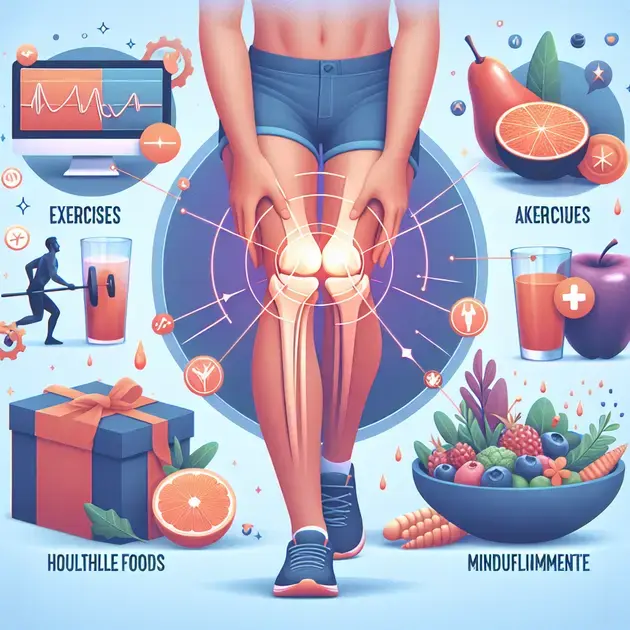Are your knees constantly causing you discomfort? Dealing with knee pain can be a challenging experience that impacts your daily life and physical activities. Whether it’s due to an injury, arthritis, or overuse, finding relief strategies is essential to improve your quality of life.
Fortunately, there are various approaches you can take to alleviate knee pain and enhance your overall well-being. From targeted exercises and stretches to incorporating anti-inflammatory foods into your diet, exploring different relief strategies can help you manage and reduce the discomfort in your knees effectively.
Strategies for Managing Knee Pain
Knee pain can be a significant hindrance to daily activities, but there are several strategies you can implement to manage it effectively. One crucial aspect is maintaining a healthy weight, as excess pounds can put unnecessary strain on your knees. Regular exercise is also essential, but it’s important to choose low-impact activities that are gentle on the knees, such as swimming or cycling.
Another key strategy is to ensure proper footwear that provides adequate support and cushioning for your knees. Additionally, incorporating yoga or tai chi into your routine can help improve flexibility and strengthen the muscles around the knee joint. Using knee braces or supports during activities that exacerbate your knee pain can also provide relief and stability.
Tracking your symptoms and identifying triggers for your knee pain is important in managing it effectively. Keeping a journal or using apps like My Pain Diary can help you monitor your symptoms and identify patterns that can inform your treatment plan. Finally, consulting with a healthcare professional or a physical therapist for personalized guidance and treatment options is crucial in managing knee pain in the long term.
Exercises and Stretches for Knee Relief
Regular exercise and stretching can play a significant role in relieving knee pain and improving flexibility and strength in the knee joint. One effective exercise is the straight leg raise, which helps strengthen the quadriceps muscles that support the knee. To perform this exercise, lie on your back with one leg bent and the other straight. Slowly lift the straight leg to the height of the bent knee and hold for a few seconds before lowering it back down.
Stretching exercises such as hamstring stretches can also help alleviate knee pain by improving flexibility in the leg muscles. A simple hamstring stretch involves sitting on the floor with one leg extended and the other bent. Lean forward from your hips towards the extended leg until you feel a gentle stretch in the back of your thigh.
Incorporating low-impact exercises like water aerobics or Pilates can also help strengthen the muscles around the knee joint without excessive strain. Apps like Daily Yoga or Nike Training Club offer guided workouts for knee relief and strengthening. It’s essential to listen to your body and avoid overdoing it to prevent further injury and promote gradual improvement.
Incorporating Anti-Inflammatory Foods for Better Knee Health
Diet plays a crucial role in managing inflammation and promoting better overall knee health. Incorporating anti-inflammatory foods such as fatty fish rich in omega-3 fatty acids, leafy greens like spinach and kale, and nuts and seeds can help reduce inflammation in the body, including the knees.
Adding turmeric to your meals or consuming turmeric supplements can also aid in reducing inflammation and relieving knee pain. Turmeric contains curcumin, a compound with powerful anti-inflammatory properties that can benefit joint health. Including fruits high in vitamin C, such as oranges and strawberries, can help promote collagen production and support the health of your knee joints.
Avoiding processed foods high in sugar and unhealthy fats is essential, as they can contribute to inflammation in the body. Apps like MyFitnessPal can help track your daily food intake and ensure you’re incorporating a balanced, anti-inflammatory diet for better knee health. Staying hydrated by drinking plenty of water is also crucial in flushing out toxins and maintaining healthy knee function.
Effective Pain Relief Techniques for Sore Knees
Pain Relief Techniques:
When it comes to managing sore knees, there are several effective pain relief techniques that can help alleviate discomfort. One common method is to use ice packs or cold compresses on the affected area to reduce inflammation and numb the pain. Applying heat pads or taking warm baths can also provide relief by relaxing the muscles around the knee joint. Additionally, over-the-counter pain medications such as ibuprofen or acetaminophen can help reduce pain and swelling.
Physical Therapy:
Another effective way to relieve knee pain is through physical therapy. A trained therapist can design a personalized exercise program to strengthen the muscles supporting the knee joint, improve flexibility, and reduce stiffness. Physical therapy can also help correct any imbalances in the body that may be contributing to knee discomfort.
Supportive Gear:
Using supportive gear such as knee braces or compression sleeves can provide stability to the knee joint and reduce strain during physical activities. Orthotic shoe inserts can also help improve alignment and reduce pressure on the knees. By wearing the right supportive gear, you can alleviate knee pain and prevent further injuries.
Massage and Acupuncture:
Massage therapy and acupuncture are alternative pain relief techniques that can be beneficial for sore knees. Massage can help increase blood flow to the affected area, reduce muscle tension, and promote relaxation. Acupuncture, on the other hand, involves inserting thin needles into specific points on the body to stimulate natural pain-relieving mechanisms. Both methods can help manage knee discomfort effectively.
Hydration and Nutrition:
Staying hydrated and maintaining a balanced diet rich in anti-inflammatory foods can play a crucial role in managing knee pain. Drinking plenty of water helps keep the joints lubricated and reduces stiffness. Consuming foods high in omega-3 fatty acids, such as salmon and walnuts, can also help reduce inflammation and alleviate soreness in the knees.
Mindfulness and Meditation for Knee Discomfort
Practice Mindfulness:
Engaging in mindfulness practices such as meditation, deep breathing exercises, or yoga can help alleviate knee discomfort by reducing stress and promoting relaxation. Mindfulness techniques focus on being present in the moment and cultivating a sense of calm, which can be beneficial for managing pain and improving overall well-being.
Visualize Healing:
Visualization techniques involve imagining the knee joint as healthy, strong, and pain-free. By visualizing the desired outcome, you can promote healing and reduce discomfort in the knees. Visualize the pain dissipating and the knee becoming more flexible and mobile with each breath.
Body Scan Meditation:
Body scan meditation involves moving your attention from one body part to another, focusing on any sensations or tension present. By bringing awareness to the knee area and releasing any tension, you can help relieve discomfort and promote relaxation. Body scan meditations can be a useful tool for managing knee discomfort.
Mind-Body Connection:
Recognizing the connection between your mind and body is essential for managing knee discomfort. Stress and negative emotions can exacerbate pain, while positive thoughts and emotions can help reduce it. By cultivating a positive mindset and practicing mindfulness, you can improve your knee health and overall well-being.
Gratitude Practice:
Expressing gratitude for your body and its ability to heal can shift your focus from pain to appreciation. Practicing gratitude daily, whether through journaling or verbal affirmations, can help change your perspective on knee discomfort and promote emotional well-being. By incorporating gratitude into your routine, you can enhance the healing process.
Top Tips for Preventing Knee Injuries
Proper Warm-Up and Stretching:
Before engaging in physical activities or exercise, it is crucial to warm up the muscles and perform stretching exercises to prepare the body and prevent knee injuries. Dynamic stretches that mimic the movements you will be doing can help improve flexibility and reduce the risk of strains or tears in the knee joints.
Wear Appropriate Footwear:
Wearing proper footwear that provides support and cushioning is essential for preventing knee injuries. Choose shoes that are designed for the specific activity you are engaging in, whether it’s running, walking, or playing sports. Good footwear can help distribute the impact of movement evenly and reduce stress on the knees.
Maintain a Healthy Weight:
Excess weight puts additional pressure on the knee joints, increasing the risk of injury and discomfort. By maintaining a healthy weight through a balanced diet and regular exercise, you can reduce the strain on your knees and lower the likelihood of developing knee-related issues.
Cross-Train and Strengthen Muscles:
Engaging in a variety of activities and sports can help prevent overuse injuries in the knees. Cross-training allows you to work different muscle groups and reduce repetitive strain on the knee joints. It is also essential to strengthen the muscles around the knees, including the quadriceps and hamstrings, to provide stability and support.
Listen to Your Body:
One of the most important tips for preventing knee injuries is to listen to your body and avoid pushing through pain. If you experience discomfort or swelling in the knees, take a break from the activity and allow your body to rest and recover. Ignoring warning signs can lead to more severe injuries down the line.
conclusão
In conclusion, effectively managing sore knees requires a multi-faceted approach that includes pain relief techniques, physical therapy, supportive gear, and mindfulness practices. Utilizing ice packs, heat pads, and over-the-counter medications can provide immediate relief by reducing inflammation and soothing discomfort. Physical therapy plays a crucial role in strengthening muscles, improving flexibility, and correcting imbalances to alleviate knee pain in the long term.
Supportive gear such as knee braces, compression sleeves, and orthotic shoe inserts offer stability and reduce strain during physical activities, preventing further injuries. Alternative methods like massage therapy and acupuncture can aid in managing knee discomfort by increasing blood flow, reducing tension, and stimulating natural pain-relieving mechanisms.
Furthermore, practicing mindfulness, visualization, and body scan meditation can help individuals cope with knee discomfort by reducing stress, promoting relaxation, and fostering a positive mind-body connection. Expressing gratitude for the body’s healing abilities can shift one’s focus from pain to appreciation, enhancing the overall healing process.

